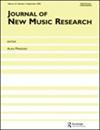使乐器具有音乐性的纠缠:重新发现社会性
IF 1.1
4区 计算机科学
Q4 COMPUTER SCIENCE, INTERDISCIPLINARY APPLICATIONS
引用次数: 8
摘要
一件东西之所以成为乐器,是因为它在社会环境中的使用,而它最初的意图设计(如果有的话)只是其中的一部分:有时只是很小的一部分。本文借鉴了“表演生态系统”的概念,认为使用数字技术的乐器设计师/制造商可能会更深入地关注音乐创作各个层面的社会背景/结构。它着眼于演奏者、乐器和环境的紧急、情境的共同发展,表明人类习惯性地使用乐器来感知、测试和探索自我-他人关系在动态、相互参与中的可能性,11因此,该标题的纠缠(例如,见Hodder,2012)是物体、人类、环境、历史和思想之间复杂的相互关系网络。这种相互依赖可能与物理或历史距离无关,尽管普遍存在,但也可能是暂时的或不可预测的。?>本文章由计算机程序翻译,如有差异,请以英文原文为准。
The entanglements which make instruments musical: Rediscovering sociality
A thing becomes a musical instrument by virtue of its use in a social context, a use of which its initial intended design (if it had one) forms only a part: sometimes a very small part. Drawing on the notion of the ‘performance ecosystem’ this papersuggests that instrument designers/makers working with digital technologies might fruitfully attend further to the social contexts/constructs that characterise every level of musicking. It looks at the emergent, situated co-development of player, instrument and environment, suggesting that humans habitually use instruments to sense out, test and probe the possibilities of self-other relations in dynamic, mutually-engaging, and often playful and improvised behaviours.1 11 The entanglements (see e.g. Hodder, 2012) of the title are therefore the complex network of interrelations between objects, humans, environments, histories and ideas. Such co-dependencies may operate irrespective of physical or historical distance, and though pervasive may also be temporary or unpredictable.?>
求助全文
通过发布文献求助,成功后即可免费获取论文全文。
去求助
来源期刊

Journal of New Music Research
工程技术-计算机:跨学科应用
CiteScore
3.20
自引率
0.00%
发文量
5
审稿时长
>12 weeks
期刊介绍:
The Journal of New Music Research (JNMR) publishes material which increases our understanding of music and musical processes by systematic, scientific and technological means. Research published in the journal is innovative, empirically grounded and often, but not exclusively, uses quantitative methods. Articles are both musically relevant and scientifically rigorous, giving full technical details. No bounds are placed on the music or musical behaviours at issue: popular music, music of diverse cultures and the canon of western classical music are all within the Journal’s scope. Articles deal with theory, analysis, composition, performance, uses of music, instruments and other music technologies. The Journal was founded in 1972 with the original title Interface to reflect its interdisciplinary nature, drawing on musicology (including music theory), computer science, psychology, acoustics, philosophy, and other disciplines.
 求助内容:
求助内容: 应助结果提醒方式:
应助结果提醒方式:


